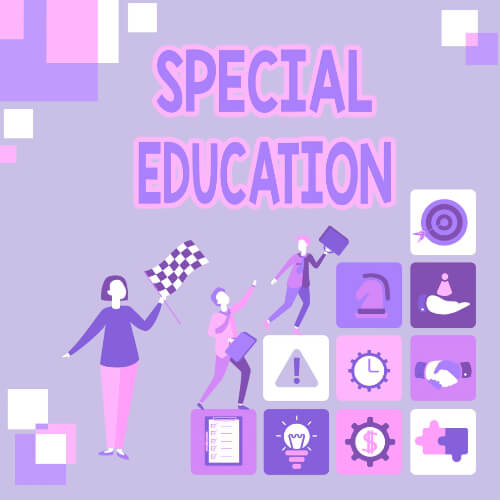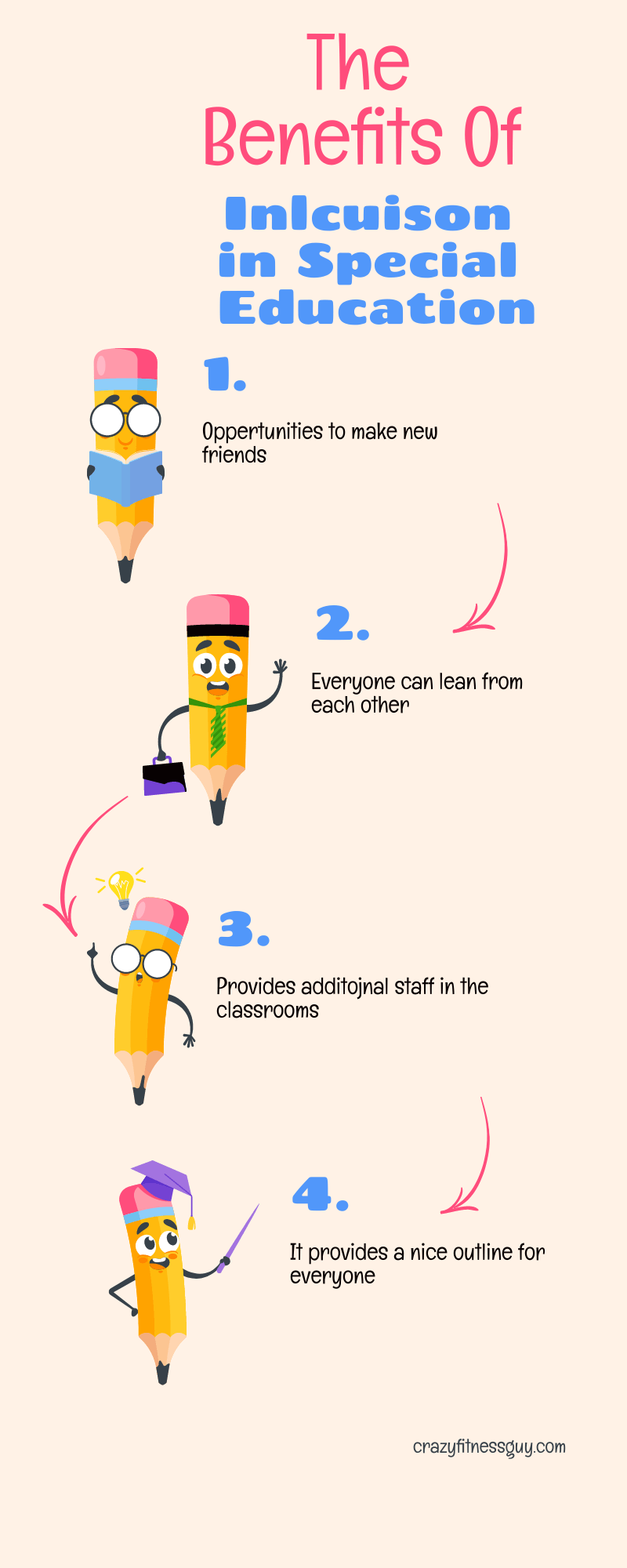Inclusion in Special Education: Advantages for all Students

Think about this for a minute if you were parents with kids with extra challenges. You wouldn't want them to feel different, would you? This is why inclusion in classrooms is important. For those who do not know what inclusion is let's learn about it together. Inclusion in special education is when students with extra challenges are placed in general education classrooms.
There are many advantages to inclusion. Some of the advantages are that all students can learn from each other, it can reduce bullying, and students with disabilities can feel like they belong. Inclusion can also help improve academic achievement for all students.
* Affiliate Disclaimer: This page contains some affiliate links. By using these links, you have no additional costs but I will be paid a commission or a discount on the service and, by doing so, you will support this site, its blog and the great work that is hidden behind every published article. Remember, I never suggest products or services that I haven't tried and that I don't consider valid. (Jimmy Clare) is an Independent Team Beachbody Coach.*
**Fitness Disclaimer:** The Service offers health, fitness and nutritional information and is designed for educational purposes only. You should not rely on this information as a substitute for, nor does it replace, professional medical advice, diagnosis, or treatment. If you have any concerns or questions about your health, you should always consult with a physician or other health-care professional. Do not disregard, avoid or delay obtaining medical or health related advice from your health-care professional because of something you may have read on the Service. The use of any information provided on the Service is solely at your own risk. (Jimmy Clare) is an Independent Team Beachbody Coach.
When Did Special Education Inclusion Begin?
The Individuals with Disabilities Act was signed by President Ford on November 29th, 1975. According to idea.edu.gov
what is the purpose of inclusion in education?
Students with accommodations were discriminated against. They did not get the services that they needed and the funding was directed toward their typical peers. The students with accommodations benefited from being with typical peers because they modeled their appropriate behavior. They needed to be with kids their own age.
The school also wanted to diversify the types of special education they have to offer. Everyone's needs are different. Special education should not be "one size fits all."
What are the advantages of inclusion in special education?
- Provides opportunities to make friends with others who do not have similar obstacles
- Provides the opportunity to learn from people different from oneself
- It provides additional teaching staff in the classroom
- Provides the whole class with a lecture outline
Provides opportunities to make friends with others who do not have similar obstacles (Explained)
Even though I felt safe in special education, there is one big drawback to it. Special Education does not provide an opportunity to meet other students who do not have accommodations. Which can make it difficult to make friends.
By not being in the same classroom as others it might feel very lonely at lunchtime or recess.
Provides the opportunity to learn from people different from oneself (Explained)
Everyone learns differently. I believe that everyone can benefit from learning from each other. For example, if student A learns better by listening to the teacher, but Student B learns better visually. Student A can later sketch an image for student B to help them learn.
It provides additional teaching staff in the classroom (Explained)
When students with accommodations have one-on-one helpers who are in the bigger classrooms with them it works out for everyone. It provides extra support for the teacher. Plus the one-on-one helper helps in small groups.
Furthermore, it just helps to have one more pair of adult eyes in the classroom to make sure everyone is behaving.
Provides the whole class with a lecture outline (Explained)
Everyone benefits from an outline. Teachers, students, and one-on-one helpers all benefit from them. Outlines help everyone to stay on track and stay on the same page.
What Is The Difference Between special education inclusion vs pull-out
The difference between special education inclusion vs pull-out is simple. Inclusion is when the student with accommodations joins in the bigger classroom with the rest of the school. While pull-out is when the student is pulled out of the classroom for a certain subject that they need extra support with.
What Are The Different Types Of Special Education Inclusion Programs?
There are many different types of inclusion for students with accommodations. Here are some of the different types of inclusions:
- Full Inclusion
- Part-time Inclusion
- Push-in Inclusion
- Self-contained Classroom
Now let's discuss the difference between all of these types of inclusion so you can decide which better suits your child.
Full Inclusion (Explained)
Students are full-time in a typical classroom setting. Special education students push into the typical classroom to be a part of everything.
Part-time Inclusion (Explained)
The student is pulled out of the classroom only for subjects in which they need extra help. For example, I needed help in math, science, history, and English. Eventually, I improved in certain areas to be able to handle a typical classroom setting. Keep in mind it did not happen in a year or two.
Push-in Inclusion (Explained)
Students in special education are only with typical peers for specials like gym, art, and music class.
Self-contained Classroom (Explained)
In other words, the students in special education stayed in special education.
What Are Some special education inclusion strategies?
If you need some ideas for special education inclusion strategies here are some ideas that could work in your classroom:
- Work with students with accommodations one-on-one
- Get to know your students so you know their preferred ways of learning
- Break content up into smaller chunks for the whole class
- Record all lectures using a digital recorder tool like podcastle
What Are The Best Practices For Special Education Inclusion?
In order for inclusion special education to work everyone and I mean everyone must do the following:
- Teachers need ongoing training throughout the school year
- School districts need to fund it
- Everyone needs to be on board with it
Now let me explain what I mean about each of these best practices for inclusion.
Teachers Need Ongoing Training (Explained)
Education teachers are lifelong learners and they need training in inclusive practices such as how to handle scheduling. They also need training in the different types of learning (visual, audio, etc).
School Districts Need To Fund It (Explained)
If school districts are going to succeed at inclusive classrooms in education they need to fund it. Money can't be thrown a few dollars here and there. Schools also need to hire additional staff, especially now more than ever because of teacher shortages.
I would also like to bring this up to all the school districts around the world. Help out with purchasing school supplies for all the teachers. Education teachers should not have to pay for everything. That goes for special education teachers and general education teachers as well.
Special education teachers work their butts off all year long they should not have to worry about buying their school supplies. Even though I did not really care about my school district back then. Looking back at it my 7th-grade special education teacher spent a lot of time learning about all of her students. I really appreciated that because she helped me address the bullying issue at my school.
What Are The Myths About Special Education Inclusion?
One of the biggest myths that I heard from someone was that special education inclusion is a big resource hog. This happened when I was living in New Jersey and my mom heard it from her friend at the conference at the school I was going to.
Another myth about inclusive classrooms is that they only benefit special education students. This is false because everyone benefits from inclusion in classrooms.
What Are The pros and cons of inclusion in special education?
Here are some of the pros and cons regarding inclusion in education.
What Are The Pros Regarding Inclusion In Education
- Everyone can learn from one another
- Teachers get extra help
- Students with accommodations get to make new friends with general education students
- Everyone likes to be included in everything
What Are The Cons Regarding Inclusion In Education
There are no cons when it comes to inclusion in education if it is done right.
Why Inclusion In Schools Is Important?
Even though I hated every second of school growing up for many different reasons. One of those reasons was that my school district did a poor job with inclusion in the classrooms. I admit I did not know what was happening when I was a kid.
The only thing I knew was that I was being taken out of the classroom unexpectedly at random times and weeks. Which through off structure to my schedule. But the reason why inclusion is important to me is that it helped me make friends with Adam.
I have been friends with Adam since second or third grade. He has seen me at my best and at my worst. His family was accepting of me and never treated me like I was different like my school district did. Because Adam and I have been best friends for so long I was one of the groomsmen at his wedding a few years ago.
The number one reason why inclusion is valuable in schools is that it helps everyone interact with people who are different than the typical student. If my school district never had inclusion I would never have met Adam. I hope my friendship with Adam continues on in the future.
Conclusion:
In conclusion, inclusion in classrooms has many advantages. It helps all students feel welcome and valued, learn to support each other, and develop a sense of community. When students feel like they belong in school, they are more likely to attend and succeed. Inclusion also benefits teachers, who report feeling more satisfied with their jobs when they have a diverse group of students in their classrooms.






























